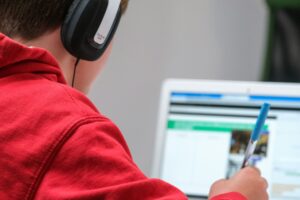Universal Design For Learning (UDL):
UDL and Inclusive Learning Environment:
UDL is a framework that strives to create a more accessible and inclusive learning environment for all students. This framework recognizes that classrooms consists of diverse students that have different type of learning styles and different backgrounds. This framework provides ways to accommodate all types of students to make the classroom more inclusive. UDL provides multiple ways for engagement, representation, action and expression. For example, multiple ways of engagement provides several design options to create a more inclusive engagement process for students. UDL practices such as understanding the differences of students and welcoming different backgrounds of the students also ensures an inclusive learning environment.
Applying UDL into Classroom:
UDL process can be applied to both physical and online learning environments. The video below is a good example of how a teacher can incorporate UDL principles into a physical classroom. The practices incorporated by the teacher includes letting students show their knowledge through different channels such as songs or writings. The teacher also welcomes different backgrounds of the students and encourages the students to incorporate their background into their learning journey. He also uses multiple tools to teach and understands the different between each students. Overall, this practices discussed in the video are good examples of how one can incorporate UDL values into physical classroom.
Accessibility in Online Settings:
Inclusion in Online Learning Environment:
Ensuring course content is accessible is vital in an online learning environment. People with disabilities, senior students, and students with limited resources can especially have difficulty accessing online content properly. To combat this, instructors should create course content clearly and organized. They should use icons consistently so it doesn’t confuse students. They should also add captions to their videos for clarity. They can also use screen readers and text-to-speech to make their content more accessible for people with disabilities and all the other students.
Equability in Online Learning Environment:
To create a more equitable learning experience, instructors can provide free or low-cost resources and they can also make the course content in a way that can be viewed in multiple devices in multiple different formats. This way students with limited resources can also access course content.
Personal Experience with Accessibility:
In my own learning experiences, having accessibility issues in an online learning environment affected my motivation and engagement for the course. If the course website and content were not working, I would feel less motivated to do the coursework because I had to figure out the accessibility issue first and do the course content which seemed very time-consuming. Therefore, I believe accessibility for all students is essential for students learning, as it would decrease student motivation and engagement if the learning environment is not accessible.

Photo by Compare Fibre on Unsplash
Ethical Challenges of EdTech:
Some Ethical Challenges of EDTech:
There are several ethical challenges of Edtech that teachers and students should be aware of. Some of these challenges include,
Collection of Personal Data: This data collection should be minimized to what is necessary and should be done to the knowledge of the students. If students want to be anonymous and not share any personal information, they should be able to do so.
Pushing Products: The second challenge is that the data collected from these can be used to analyze the learning patterns of students and can be used by EdTech companies to push products to students which limits their options.
Discrimination: The other challenge with this data collection is that it could be used to discriminate against students based on race, gender sexuality, etc. This can create inequality in online learning spaces.
How to Balance Ethics and Edtech:
Teachers should use platforms that collects limited date. The teachers can also use platforms that informs students about data collection and the handling of the collected data. This way teachers can use EdTech and combat the ethical concerns. To avoid ethical concerns of the EdTech, the teachers should also inform the students and parents about the data collection and help them use the educational technology responsibly.

Photo by Maya Maceka on Unsplash
Ethical Considerations in Digital Interactions:
Ethics in Digital Environments:
Ethical considerations in digital interactions are critical to learning about all people who use the internet. Most online platforms and social media require people to share their personal information to allow usage. This personal information is mostly used to personalize the experience of the user. These could cause some ethical issues such as products being pushed to the user based on their personal information and these data being used for discrimination. These issues happen both in educational environments and social settings.
Responsibilities as an Online Participant:
The responsibilities I have as a participant in these platforms consist of being aware of how my information is used and collected. I should safeguard my personal information and be careful when I share any of my personal information. The responsibilities I have as a user also include being careful about my privacy settings on the websites that I visit and being aware of the data that is being collected from me. This includes the personal information I share online and the consent that I give for entering the websites.
Ensuring Positive Digital Interactions:
To ensure positive digital interactions, people should use respectful language and tone on digital environments. In addition to that, people should be culturally sensitive and inclusive on digital environments. This can be done by being aware of culture differences and making sure people are not excluded. Moreover, people should avoid spreading misinformation , when sharing online content. These are couple practices that can ensure positive interactions on digital environments.

Photo by Wes Hicks on Unsplash
Applying UDL and Accessibility Principals:
Reflection on Previous Online Courses:
I feel like as a student so far my professors have addressed the issues of accessibility and adequately applied the principles of UDL. Most of the courses I have taken had multiple ways to engage the students and increase participation. Moreover, the courses I have taken have been very welcoming of different perspectives and ideas. The courses that I had also involved multiple ways to show what I have learned such as essays, tests, and group projects.
Recommended Improvements:
I feel like some aspects of my courses could have been improved to make the course more accessible for all students. These practices would include
Adding more resources: These would help students with different learning styles to learn the material from different sources provided by the professor.
Giving more clear feedback: This would help students understand where they are struggling and where they need to work more. I think these would have helped and improved my classes.

Photo by Marvin Meyer on Unsplash



